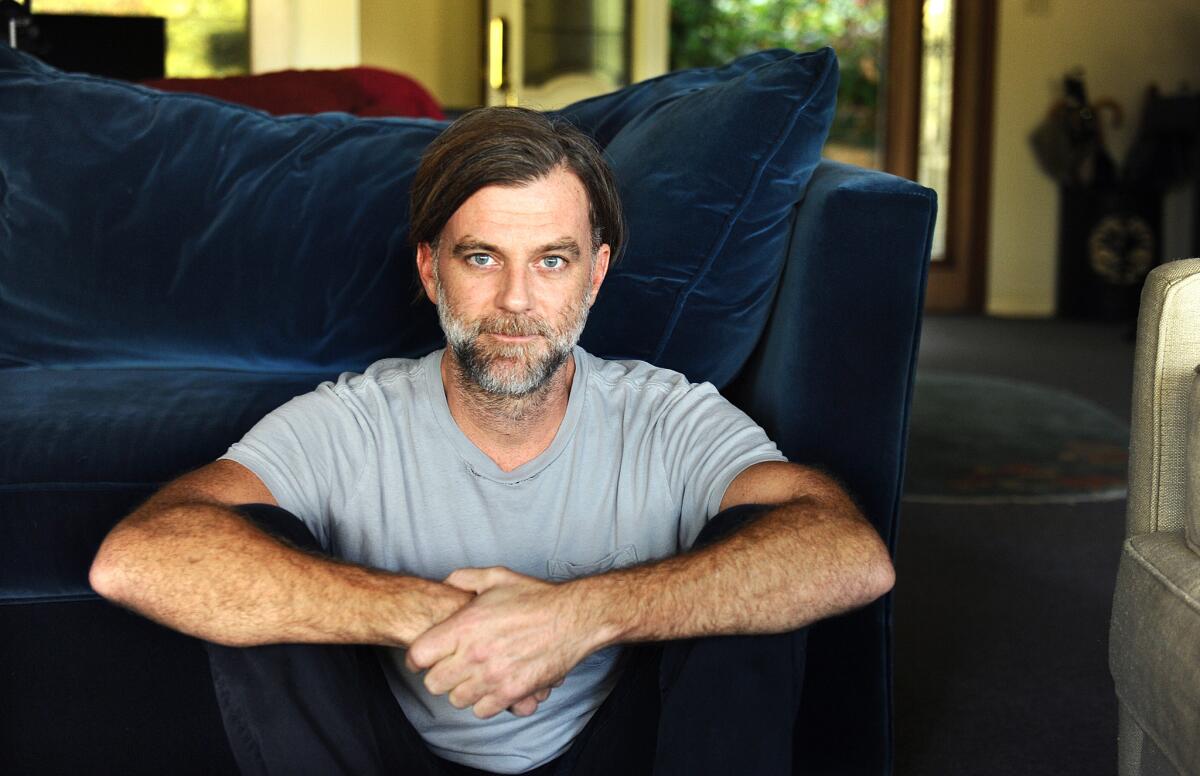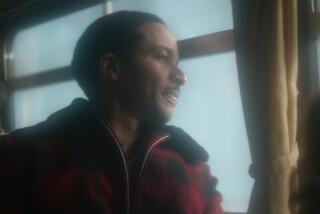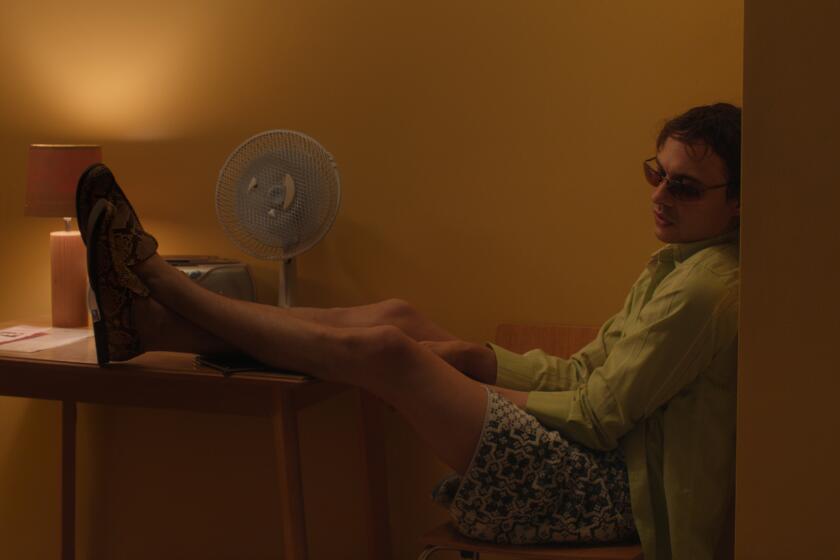Movie Sneaks: Paul Thomas Anderson takes on ‘Inherent Vice’

- Share via
If only Paul Thomas Anderson could remember what drew him to the story of “Inherent Vice” in the first place. Or, more specifically, by making a movie of cultural confusion, spiritual uncertainty and overall disorientation set in 1970 — perhaps not coincidentally the year Anderson was born — is he looking to say something about right now?
“I’m still not sure of the answer to that even having done it,” Anderson said recently, settling in on the backyard patio of the rental house where he has edited his last two films, with an expansive view of the Valley below bathed in a late afternoon glow.
“Inherent Vice” is a shaggy dog underdog story, the tale of Larry “Doc” Sportello, a hippie detective sent on a vague mission in and around Los Angeles by an ex-girlfriend who broke his heart. Loose and funny, the movie’s flaky fog is cut through by a sharp edge of sadness and loss — the feeling that something good is over and is not coming back.
In his investigation, Doc (played with tones of weary, frayed hopefulness by Joaquin Phoenix) repeatedly comes in contact with the Golden Fang, a multipurpose shadow organization with interests that include international drug trafficking and Southland dentistry.
“Let me put it this way, the Golden Fang is still in business,” Anderson comes around to saying. “And they’ve always been in business. And I don’t see them getting out of business any time soon. Which is a drag, but maybe that’s just the way that it is.”
In a passage from the Thomas Pynchon novel not in the movie — “Believe me, I’ll have many sleepless nights about what’s not in this film,” Anderson said — Doc is described as “caught in a low-level bummer he couldn’t find a way out of, about how the Psychedelic Sixties, this little parenthesis of light, might close after all, and all be lost, taken back into darkness.”
Anderson is a writer, director, producer and five-time Oscar nominee who has gone from young prodigy of overwhelming promise to idiosyncratic maker of films with visionary sweep and exploratory expansiveness. Opening Dec. 12 after a high-profile premiere at the recent New York Film Festival, “Inherent Vice” arrives with an additional air of anticipation and expectation for being the first major screen adaptation of a novel by the celebrated, notoriously private author. It’s funny, in the dual sense of being both a comedy and also deeply weird.
“Inherent Vice” lines up chronologically with Anderson’s previous two films to create something of an extended survey of power and masculinity in the American 20th century with a special focus on the mythologies of Southern California. After the economic and geographic expansion of 2007’s “There Will Be Blood” and inward-looking tug-of-war between the mind and the spirit in 2012’s “The Master,” Anderson has gone really far out.
Anderson humors a theory that Doc is Freddie Quell (the rascal vagabond played by Phoenix in “The Master”) a few drifting years down the line, countering with his own notion that Freddie might have started up something akin to L.A.’s utopian commune the Source Family. There is something in Doc that just wants to help, even when doing so is not what’s best for him.
“He’s on the case. And I don’t know if he knows what the case is, but he’s on it,” explained Anderson. “So he’s a puppy dog and a pit bull together. I like that a lot. I think he’s desperate to find out what went wrong, not just with his own love life but with his country.”
An L.A. story
A native of Los Angeles, where he lives with actress Maya Rudolph and their four children, Anderson bounds between a bouncy, youthful energy and a thoughtful, controlled stillness. With a grown-out mop of hair he sometimes presses back behind his ears with both hands, he has a sandy scruff on his face that looks like he forgot to shave for so long he woke up one day with a beard.
Set in the fictional South Bay surf shack community of Gordita Beach, the story of “Inherent Vice” begins when Doc is paid a surprise visit by a former flame, Shasta Fay Hepworth (Katherine Waterston), in need of help. This sets him off on a wayward course throughout Los Angeles, intersecting with real estate developers, the FBI, political militants, local cops, groovy masseuses, ominous therapists and the ever-evolving presence of the Golden Fang.
The structure of Doc’s investigation is such that the movie is stocked with an elastic, ever-surprising cast that includes Josh Brolin, Reese Witherspoon, Owen Wilson, Benicio Del Toro, Eric Roberts, Maya Rudolph, Michael Kenneth Williams, Jena Malone, Jeannie Berlin, Martin Donovan and Martin Short.
“Eggs break, chocolate melts, glass shatters” is how Doc’s lawyer explains the legal term that gives the film and the book its title, the defect that causes something’s demise. And much like in “The Big Sleep” or “The Big Lebowski,” the actual details in the story of what becomes of who may end up a bit fuzzy as the initial mystery is solved but also somewhat thrown aside.
“Trying to make the movie feel how the book made me feel, or how Pynchon in general made me feel, there are many times where I feel lost, but never in a bad way,” Anderson said. “If I’m participating with the book on its terms and it’s not giving me what I want it to give me, then maybe that’s on me. Maybe I just need to giggle and give in a little bit.
“It’s like getting high and being nervous about it,” he instructed. “Just enjoy the high. Just sit back and relax. Don’t freak out.”
The film is an extension of the working methods Anderson has employed since 2002’s “Punch-Drunk Love,” a mix of preparation and spontaneity. Shot in summer 2013 all around Greater Los Angeles for around $20 million, the film’s look, alternately inky dark and sun-bleached faded, was created on 35 mm film by cinematographer Robert Elswit (who won an Oscar for his work on “There Will Be Blood”), with a lurking score composed by Radiohead’s Jonny Greenwood.
Anderson’s producer JoAnne Sellar has worked with him since his second feature, “Boogie Nights,” and has witnessed firsthand the developing openness in Anderson’s style.
For example, a scene in which Wilson, playing a surf-rock saxophonist turned unwilling government provocateur, attempts to explain the depths of an ongoing conspiracy to Doc was originally shot inside a tepee, with a completely different tone. Unsatisfied, Anderson brought Wilson back a few weeks later to create a centerpiece moment of spooky simplicity as the pair are seated alone at a table with a slow-moving zoom creeping in on them.
“On ‘Boogie Nights,’ when I joined him, he was very, very clear on what he was doing,” said Sellar. “It was very mapped out, and he knew beforehand in his head almost every shot. Everything was completely figured out. I would say as he gained confidence as a filmmaker, he allowed himself not to be so rigid from the get-go. There just seems more of a spontaneity and fluidity in his work that wasn’t there so much at the beginning.”
‘No turning back’
Anderson first considered adapting Pynchon’s “Vineland” or “Mason & Dixon” before the book “Inherent Vice” was released in 2009. At first he wasn’t sure if he wanted to make another period story set in Southern California, concerned over retreading ground from his 1970s-’80s exploration in “Boogie Nights” or coming too close to the world of Robert Altman’s “The Long Goodbye.” But almost as if the story had begun to exert a power of its own, he found himself propping up the novel with a cookbook holder and typing it out line by line into the form of a screenplay.
“The next thing you know, you’re in love with the characters and it’s got its hooks in you, and there’s no turning back,” he said. “Doc was a great character, and I have to believe that’s probably the main thrust of it, parallel with just wanting to collaborate with a Pynchon book.
“Whatever book it was actually didn’t so much matter. It was using his take on the world and working with that as a collaborator that was the most valuable.”
Pynchon has not been willingly publicly photographed in more than 50 years. As to the nature of any direct communication with the author, whether they ever met in person or that Pynchon reportedly appears in the film, Anderson shut down that conversation fast, saying, “We can’t go down that route of Pynchon-talk.”
Besides altering the story’s ending, Anderson’s biggest transformation from the novel is to make a passing character known as Sortilège into the narrator, allowing more of Pynchon’s own dense, evocative language into the film. Anderson likens his use of the character, played by the musician Joanna Newsom, to Jiminy Cricket or when you decide on just the right topping to go with perfectly scrambled eggs, making a good thing better.
In one scene Sortilège is riding in the car with Doc, talking but not exactly to him. Then she’s gone, no longer occupying the seat where she was. It’s one of numerous moments in “Inherent Vice” that place it in some interzone of dream, memory or druggy misperception.
“This friend of mine made me so happy, he saw it and said, ‘She’s in the car and then she’s not in the car. That’s why I love movies,’” Anderson said. “And I was like … right, the point is a cut, it’s so exclusive to film. You couldn’t do that in a book.”
Twitter: @IndieFocus
More to Read
Only good movies
Get the Indie Focus newsletter, Mark Olsen's weekly guide to the world of cinema.
You may occasionally receive promotional content from the Los Angeles Times.











